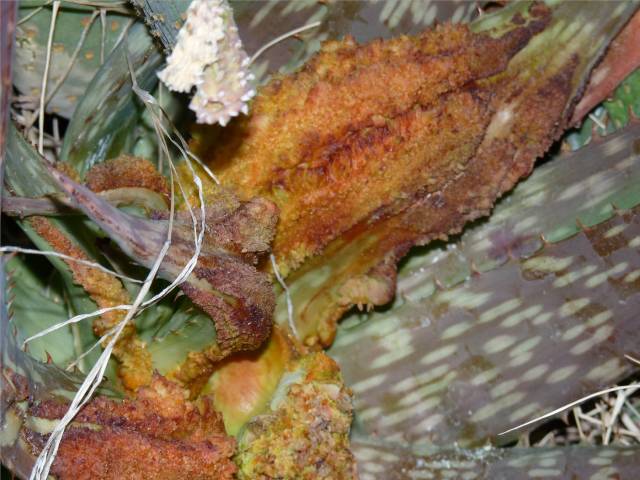Question
 Aloe Saponaria Deformi
Aloe Saponaria Deformi
I "inherited" a very large aloe bed at our new house. I have no idea how old the plants are and I believe they are saponaria from descriptions I have read. They turned a purplish color in the winter, have very sharp brown teeth and are now sending up tall stalks with reddish orange bell shaped flowers that the hummingbirds love. The problem I am writing about is a strange growth or deformity I am finding in the bed on the plants. Right now it seems to be confined to one end of the bed and is not throughout which would suggest some type of fungus or disease to me. Last year, at the end of the summer, I noticed one or two plants with a twisted and lumpy stalk and the central leaves of the rosette appeared to have growths all over them of a rust and yellow color, though some of it was a normal green. The growths are part of the skin of the plant leaves and don't appear to be on the plant's surface. When I brushed at them they did not come off but could be cut off. The growths are not smooth but almost hairy-though not a hair like a fungus-it is the skin in hundreds of hairlike bumps protruding outwards. This spring when I went to weed in the aloe bed I found about 8 plants with this problem whereas last summer there was one or two. I pulled out some of the easier to get to plants with the growths, but I just don't know if I should go after them all or let it be and see. The bed is above a retaining wall and not easily accessible. I can't find any references to aloe diseases online. What to do? I have more photos at this address: http://www.flickr.com/photos/krobbjohnson
AnswerHello Kim,
Unfortunately, this is a really bad condition, especially since it is at the base of the plant. My expertise isn't on aloe plants, so I do not know what the disease is. I strongly suggest you transplant some of your aloe off the bed. They are too crowded and may be related to the infection. This may be helpful because the soil in which the aloe are in may be dangerous. I see a healthy cactus in your photo, so it may not be water-related (unless the image doesn't provide enough quality to show wrinkles).






